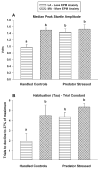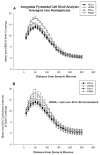Dendritic morphology of amygdala and hippocampal neurons in more and less predator stress responsive rats and more and less spontaneously anxious handled controls
- PMID: 21925210
- PMCID: PMC3586250
- DOI: 10.1016/j.bbr.2011.09.009
Dendritic morphology of amygdala and hippocampal neurons in more and less predator stress responsive rats and more and less spontaneously anxious handled controls
Abstract
We investigated the neurobiological bases of variation in response to predator stress (PS). Sixteen days after treatment (PS or handling), rats were grouped according to anxiety in the elevated plus maze (EPM). Acoustic startle was also measured. We examined the structure of dendritic trees of basolateral amygdala (BLA) output neurons (stellate and pyramidal cells) and of dorsal hippocampal (DHC) dentate granule cells of less anxious (LA) and more (extremely) anxious (MA) stressed animals (PSLA and PSMA). Handled controls (HC) which were less anxious (HCLA) and spontaneously more anxious (HCMA) equivalently to predator stressed subgroups were also studied. Golgi analysis revealed BLA output neurons of HCMA rats exhibited longer, more branched dendrites with higher spine density than the other groups of rats, which did not differ. Finally, spine density of DHC granule cells was equally depressed in HCMA and PSMA rats relative to HCLA and PSLA rats. Total dendritic length of BLA pyramidal and stellate cells (positive predictor) and DHC spine density (negative predictor) together accounted for 96% of the variance of anxiety of handled rats. DHC spine density was a negative predictor of PSMA and PSLA anxiety, accounting for 70% of the variance. Data are discussed in the context of morphological differences as phenotypic markers of a genetic predisposition to anxiety in handled controls, and a possible genetic vulnerability to predator stress expressed as reduced spine density in the DHC. Significance of findings for animal models of anxiety and hyperarousal comorbidities of PTSD are discussed.
Copyright © 2011 Elsevier B.V. All rights reserved.
Figures












References
-
- Stam R. PTSD and stress sensitisation: a tale of brain and body Part 1: human Studies. Neurosci Biobehav Rev. 2007;31(4):530–57. - PubMed
-
- Kessler RC, Berglund P, Demler O, Jin R, Merikangas KR, Walters EE. Lifetime prevalence and age-of-onset distributions of DSM-IV disorders in the National Comorbidity Survey Replication. Arch Gen Psychiatry. 2005;62(6):593–602. - PubMed
-
- Kessler RC, Sonnega A, Bromet E, Hughes M, Nelson CB. Posttraumatic stress disorder in the National Comorbidity Survey. Arch Gen Psychiatry. 1995;52(12):1048–60. - PubMed
-
- Heinrichs M, Wagner D, Schoch W, Soravia LM, Hellhammer DH, Ehlert U. Predicting posttraumatic stress symptoms from pretraumatic risk factors: a 2-year prospective follow-up study in firefighters. Am J Psychiatry. 2005;162(12):2276–86. - PubMed
-
- McNally RJ. Psychological mechanisms in acute response to trauma. Biol Psychiatry. 2003;53(9):779–88. - PubMed
Publication types
MeSH terms
Grants and funding
LinkOut - more resources
Full Text Sources
Medical
Miscellaneous

